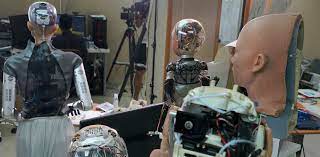COVID-19 has brought about numerous, devastating changes to people’s lives globally. With the number of cases rising across Canada and globally, we are also witnessing the development and use of robots to perform jobs in some workplaces that are deemed unsafe for humans.
Source: The Conversation
There are cases of robots being used to disinfect health-care facilities, deliver drugs to patients and perform temperature checks. In April 2020, doctors at a Boston hospital used Boston Dynamics’ quadruped robot called Spot to reduce health-care workers exposure to SARS-CoV-2, the virus that causes COVID-19. By equipping Spot with an iPad and a two-way radio, doctors and patients could communicate in real-time.

In these instances, the use of robots is certainly justified because they can directly aid in lowering COVID-19 transmission rates and reducing the unnecessary exposure of health-care workers to the virus. But, as we know, robots are also performing these tasks outside of health-care settings, including at airports, offices, retail spaces and restaurants.
This is precisely where the issue of robot use gets complicated.
Robots in the workplace
The type of labour that these and other robots perform or, in some cases, replace, is labour that is generally considered low-paying, ranging from cleaners and fast food workers to security guards and factory employees. Not only do many of these workers in Canada earn minimum wage, the majority are racialized women and youth between the ages of 15 to 24.
The use of robots also affects immigrant populations. The gap between immigrant workers earning minimum wage and Canadian-born workers has more than doubled. In 2008, 5.3 per cent of both immigrant and Canadian-born workers earned minimum wage, compared to 2018 where 12 per cent of immigrant workers earned minimum wage and only 9.8 per cent of Canadian-born workers earned minimum wage. Canada’s reliance on migrant workers as a source of cheap and disposable labour, has intensified the exploitation of workers.
McDonald’s has replaced cashiers with self-service kiosks. It has also begun testing robots to replace both cooks and servers. Walmart has begun using robots to clean store floors, while also increasing their usage in warehouses.
Nowhere is the implementation of robots more apparent than Amazon’s use of them in its fulfilment centres. As information scholars applying marxist theory Nick Dyer-Witheford, Atle Mikkola Kjøsen and James Steinhoff explain, Amazon’s use of robots have reduced order times and increased warehouse space, allowing for 50 per cent more inventory in areas where robots are used, and have saved Amazon’s power costs by working in the dark and without air conditioning.
Already marginalized labourers are most affected by robots. In other words, human labour that can be mechanized, routinized or automated to some extent, is work that is deemed to be expendable because it is seen to be replaceable. It is work that is stripped of any humanity in the name of efficiency and cost-effectiveness for massive corporations. However, the influence of corporations on robot development goes beyond cost-saving measures.
Robot violence
The emergence of Boston Dynamics’ Spot, gives us some insight into how robots have crossed from the battlefield into urban spaces. Boston Dynamics’ robot development program has long been funded by the American Defense Advanced Research Projects Agency (DARPA).
In 2005, Boston Dynamics received funding from DARPA to develop one of its first quadruped robots known as BigDog, a robotic pack mule that was used to assist soldiers across rough terrain. In 2012, Boston Dynamics and DARPA revealed another quadruped robot known as AlphaDog, designed to primarily carry military gear for soldiers.
The development of Spot would have been be impossible without these previous, DARPA-funded initiatives. While the founder of Boston Dynamics, Marc Raibert, has claimed that Spot will not be turned into a weapon, the company leased Spot to the Massachusetts State Police bomb squad in 2019 for a 90-day period.
In February 2021, the New York Police Department used Spot to investigate the scene of a home invasion. And, in April 2021, Spot was deployed by the French Army in a series of military exercises to evaluate its usefulness on the future battlefield.
Targeting the most vulnerable
These examples are not intended to altogether dismiss the importance of some robots. This is particularly the case in health care, where robots continue to help doctors improve patient outcomes. Instead, these examples should serve as a call for governments to intervene in order to prevent a proliferation of robot use across different spaces.
More importantly, this is a call to prevent the multiple forms of exploitation that already affect marginalized groups. Since technological innovation has a tendency to outpace legislation and regulatory controls, it is imperative that lawmakers step in before it is too late.
Source: The Conversation

































Leave a Comment
You must be logged in to post a comment.